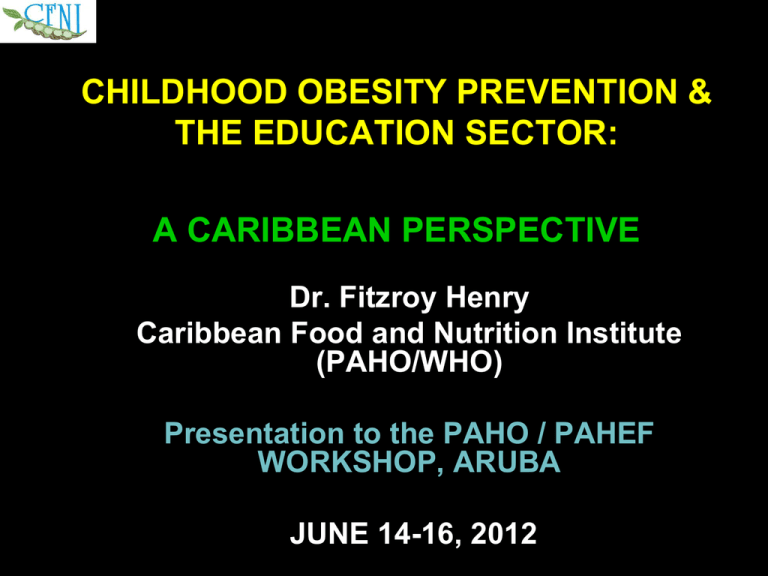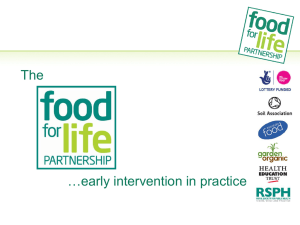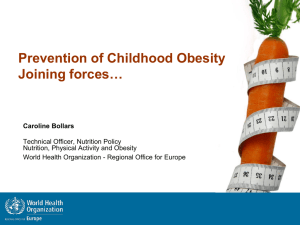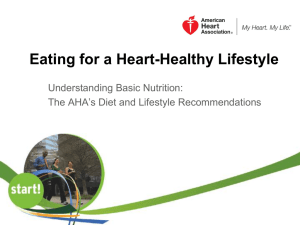Education Sector
advertisement

CHILDHOOD OBESITY PREVENTION & THE EDUCATION SECTOR: A CARIBBEAN PERSPECTIVE Dr. Fitzroy Henry Caribbean Food and Nutrition Institute (PAHO/WHO) Presentation to the PAHO / PAHEF WORKSHOP, ARUBA JUNE 14-16, 2012 OUTLINE OF PRESENTATION • CHILDHOOD OBESITY & THE CHALLENGE FOR THE EDUCATION SECTOR • TARGET 1-4: SCHOOL • TARGET 5: COMMUNITY • TARGET 6: PUBLIC • CRITICAL STRATEGIES FOR THE CARIBBEAN VICIOUS CYCLE OF EDUCATION & NUTRITION POOR NUTRITION (UNDERNUTRITION /OBESITY) POOR EDUCATIONAL ACHIEVEMENT OBESITY & LEARNING Obesity is significantly associated with cognitive impairment, specifically learning and memory functions. 7 6 5 4 3 2 1 0 19 90 19 91 19 92 19 93 19 94 19 95 19 96 19 97 19 98 19 99 20 00 20 01 % Trends in under- and over weight (WHZ) among children 0-5 yrs in the Caribbean Wasting Overw t CHANGE (%) IN UNDERNUTRITION AND OBESITY OF CHILDREN (0-5yrs) IN THE CARIBBEAN 2000-2010 15 10 2000 2010 5 0 underwt overwt NUTRITIONAL STATUS OF CARIBBEAN CHILDREN 11-13 YEARS OLD (2008) BOYS N=812 % 6 GIRLS N=1049 % 4 67 63 OVERWEIGHT >1SD 14 19 OBESE >2SD 13 14 THIN <2SD NORMAL ADULT OVERWEIGHT/OBESITY TRENDS IN THE CARIBBEAN 80 (%) 60 Male Female 40 20 0 1970s 1980s 1990s 2000s Traditional strategies will continue to fail Traditional View: Obesity is a personal disorder that needs treatment Current View: (i) Obesity is a normal response to an abnormal Environment (ii) The Environment is complex but mainly obesogenic The Complexity Of Healthy Eating & Childhood obesity REDUCING THE COMPLEXITY - FOR INTERVENTION ACCESSIBLE HEALTHY FOODS ~ COST AVAILABLE HEALTHY FOODS MARKET PRESSURE MEDIA, FRANCHISES PEERS . CHILDHOOD OBESITY PHYSICAL ACTIVITY SPACES AVAILABLE, ATTRACTIVE & SAFE FOOD PREP P0RTION SIZE LABELS KNOWLEDGE OF WHAT TO EAT / HOW TO EXERCISE VS CULTURAL PREFERENCES WHAT CAN THE EDUCATION SECTOR DO TO COMBAT CHILDHOOD OBESITY? TARGETS FOR POLICY: 1. SCHOOL FEEDING 2. SCHOOL VENDING 3. PHYSICAL EDUCATION 4. CLASSROOM EDUCATION 5. COMMUNITY EDUCATION 6. PUBLIC EDUCATION TARGET 1: SCHOOL FEEDING PROGRAMS SCHOOL FEEDING - KEY QUESTIONS? • Programs aim to target socio-economically and nutritionally challenged children - Should this be our main target? • Programs do not have strict targeting criteria (self selection and perceived needs by teachers) - Are we contributing to the child obesity problem? • Meals usually do not include foods from most of the food groups - Are we using scientific methods or guesswork? MAJOR QUESTIONS Are we using existing resources effectively? Do countries have written policies? ONLY 47% OF STUDENTS 11-13 yrs old eat breakfast every morning A PARENTAL OR GOVERNMENTAL RESPONSIBILITY? Nutrient Standards based on Recommended Dietary Allowances Variable Age Value Unit years Gender 4-6 4-6 M F Target (mean) 20% 25% Body Weight kg 19.7 18.6 Energy kcal 1800 1625 342.5 428 MJ 7.53 6.79 1.432 2 Protein g 22 21 4.3 5 Vitamin A REd μg 400 400 80 100 Vitamin De μg 5 5 1 1 Vitamin Ef mg α-TE 7 7 1.4 2 Thiamine mg 0.7 0.7 0.14 0 Riboflavin mg 1.0 0.9 0.19 0 Niacin NEg mg 12 11 2.3 3 Ascorbic Acid mg 60 60 12 15 Pyridoxine B6 mg 0.3 0.4 0.07 0 Folacin μg 100 100 20 25 Vitamin. B12 μg 0.9 0.9 0.18 0 Calcium mg 500 500 100 125 Magnesium f mg 200 200 40 50 Iron mg 10 10 2 3 Sodium mg 300 300 60 75 Potassium mg 1400 1400 280 350 Zinc mg 10 10 2 3 Notes: • Use the RDA to determine nutrient requirements / needs • Help to correct under- and control obesity • Use culturally appropriate local foods/meals From Nutrients to Meals Meal Plans Reference Nutrients Calories 342.5 kcal Food Group Exchanges Kcal Protein 15 g Food From Animals 1.5 112.5 Fat 13 g Staples 1.5 105 Vitamin A 80 Fruits 0.5 20 Vitamin C 20 mg Vegetables 0.5 18 Iron 4 mg Fats & Oils 1 45 Calcium 200 mg Sugar 2 40 Adjusted Meal standard Total 342.5 Carbohydrates 49% 42g Protein 17% 15 g Fat 34% 13 g 2 oz meat or substitute 4 oz rice, cereal or provision 2 oz vegetable 1 tsp gravy or substitute 4 oz drink (2 oz juice & 2 tsp sugar) Average Meal Cost US$ 1.10 CRITICAL STRATEGIES – T1 SCHOOL FEEDING PROG’MS 1. Define the target groups and their needs 2. Establish nutrient standards and convert to meal standards 3. Organize local farmers to supply food items to school feeding programs 4. Provide adequate budgets to meet these healthy options 5. Implement menu with standard meals and manage resources accordingly 6. Develop Dietary Guidelines for school nutrition programs 7. Monitor and adjust according to evaluation TARGET 2: SCHOOL VENDING TARGETS FOR INTERVENTION Sources of Lunch Source (%) CAR Home 50 School Canteen 15 Tuck Shop 14 Vendors 11 Others (machines, etc) 10 WHAT ARE STUDENTS EATING? ONE OR MORE PER DAY % SNACKS 57 MEAT/FISH/EGGS 56 CARBONATED DRINKS 52 MILK/MILK PRODUCTS 35 VEGETABLES 29 FRUITS 27 OTHERS 30 FOOD PRICE & DEMAND USA – 12 SCHOOLS + 12 WORK 55 Vending Machines - 12 Months LOW FAT SNACKS Price % 10 ↓ Purchasing % 25 ↓ 50 ↓ 39 ↑ 93 ↑ 9↑ Why a School Vending Machine Policy • Usually stocked with high fat, sugar and salt foods • May undermine what children are taught in the classroom about healthy eating A vending machine policy must be linked to a wider school nutrition policy which takes into account the school community, the school curriculum, health services, access to food that is safe and meets nutrient requirements. Perspective 1 – Provide Healthy Choices Only • Research shows that children, especially young children, are less likely to make nutritious choices when other choices are available (USDA, 2005) • Schools provide clear rules for course of study and dress code and the same should go for meals Perspective 2 – Allow students to Exercise Choice • Students learn to make better decisions if they are provided with a wide assortment of food choices • Concern about the stigma attached to those foods that are labeled as ‘bad’ for health since all foods can fit into a healthy diet Policies in the Caribbean • Most countries are yet to develop a policy • In a draft document for Barbados titled ‘Nutritious and Healthy Foods in Schools – National and Practical Guidelines for Barbados 2009’ it is recommended that ‘schools should ensure that all sales of snacks, foods and drinks, including those sold from vending machines, fit into the whole-school food policy’ Policies in the Caribbean • The document goes further to provide specific guidelines: • Drinks-vending machines should be stocked with 100% fruit juices, fresh low fat (1%) or fat free (skimmed) milk and flavoured milks or soy beverages with less than 10% added sugar • Vending machines at schools should always provide water and fruit as options Recommended/Policy Initiatives • All vending machine policies should have as their foundation the FBDGs • National governments should have an approved policy on school health that includes access to healthy foods at schools including availability of vending machines. Recommended/Policy Initiatives • Vending machines should only be included in schools/countries where it is possible to have a variety of healthy options to promote appropriate nutritional status and cognitive development • Access to the vending machine should be at usual school designated break times – recess times and lunch times Recommended/Policy Initiatives • Food items should be nutritious and healthy and meet the nutritional requirements of adolescents without putting them at risk for obesity and other chronic diseases CRITICAL STRATEGIES - T2 SCHOOL VENDING 1. Establish specifications for school canteen tenders. 2. Implement an inspection process to ensure food service providers comply with nutrient-based standards 3. Establish a meal pricing policy to blend nutrients with preferences 4. Integration of school foodservice and nutrition curriculum & training (staff & Students) 5. Regular evaluation with feedback from caterers and students 6. Require vending machines to stock bottled water, appropriate sized fruit juices and low sugar beverages. TARGET 3: PHYSICAL EDUCATION nt Countries An d tig ua d a a s bu d t e m ica an d /B ar Is l in a in om Su r in id a uc i Is . er ra on ts D s G uy an a Tr in St .L ay m an M C in e na da na d G re G re Vi rg an Br iti sh in ce St .V Percent Physical Activity Levels among 13-15 year olds in the Caribbean Global School-based Health Survey 35 30 25 20 15 10 5 0 h d Is l s a Is . an d ay m an in C Vi rg bu d /B ar d uc ia id a St .L Tr in t an a G uy er ra na da e s am in e on ts M G re rin na d Su G re tig ua an An nt Br iti s in ce St .V Percent Level of Sedentary Activities among Children aged 13-15 Years in the Caribbean 80 70 60 50 40 30 20 10 0 Mean distance (cm) Fitness Test – Flexibility ‘Trunk-lift’ Females 25 Males 20 15 HFZ 10 Mean distance 5 0 11y 12y 13y 14y 11y Age (years) 12y 13y 14y Fitness Test – Muscular Strength Mean # of Push-Ups Females # of push ups 15 Males 10 5 HFZ 0 11y 12y 13y 14y 11y Age (years) 12y 13y 14y mean push ups SIT - UPs Fitness Test – Muscular Endurance SIT-UPs 80 60 40 20 0 Male Female Pass Fail CRITICAL STRATEGIES - T3 PHYSICAL EDUCATION • Create an environment where play and exercise are actively enabled and encouraged. • Make compulsory - physical education to enable 60 mins of moderate PA most days of the week • Introduce innovative & fun-oriented PA programs not only for the athletically gifted • Encourage children to drink water as the most appropriate rehydration fluid • Provide incentives to the private sector to invest in swimming pools and safe recreational spaces & facilities TARGET 4: CLASSROOM EDUCATION & INFORMATION INCORRECT ANSWERS (%) Which foods to eat sparingly? 53 Min. time someone my age should exercise? The need to eat breakfast daily? 64 What to do to maintain my right weight? 90 The need to eat a variety of foods daily? 93 A diet with the right variety of foods includes? Why do we need to be physically active? 95 An adequate variety of PA includes? 92 86 79 Students Nutrition Information (%) Source CARIB PARENTS & RELATIVES SCHOOL 76 BOOKS/MAG’NE 53 FRIENDS 21 INTERNET 20 DOCTOR OTHER (TV etc.) 53 9 20 CRITICAL STRATEGIES – T4 EDUCATION / INFORMATION • Establish in each school zone a qualified dietitian / nutritionist to plan, coordinate, train and monitor activities • Make mandatory - training for school meal providers and teachers so children will receive consistent information about healthy eating • Schools should provide guidance to parents on nutritionally appropriate packed lunches • Train food service providers on innovative ways to offer fat free, and low calorie nutritious meals • Make school staff positive role models in their own food selection and attitude to physical activity • Tailor advertisement (media) to change the thinking and practices of children towards healthy diets and food choices TOWARDS HEALTH PROMOTING SCHOOLS SCHOOL FEEDING HEALTHY EATING HEALTH PROMOTING SCHOOLS A NEW APPROACH NEEDED 12 LESSONS LEARNT 1. 2. 3. 4. 5. Conceptualization Design Planning Teams Project Management Teaching methods and Materials 6. Training of Teachers 7. Teacher Motivation 8. Standards – 9. 10. 11. 12. • Desired – Ideal, based on the research • Reality – What actually happens Nutrient, meal, menu Monitoring & Evaluation Resources Disruptions Policy • Suggest – What we would recommend or do differently School–based Behavioural Intervention in Four Caribbean Countries PROJECT GOAL REDUCE OBESITY THROUGH BEHAVIORAL INTERVENTION KEY PROJECT STRATEGY PROMOTE HEALTY LIFESTYLE BEHAVIOURS FOR 3 YRS TO A COHORT FROM GRADES 7-9 (Forms 1-3). Specific Project Objectives 1. IMPROVED DIET AND PHYSICAL ACTIVITY PATTERNS 2. SUSTAINABLE LIFESTYLE INTERVENTIONS Lifestyle Intervention The WDF-CFNI healthy School We promote healthy eating and active living Diet and Physical Activity Behavioural Curriculum Eat Fruits and Vegetables Daily Reduce Sugary Snacks & Drinks Eat a Variety of Foods Daily Eat Breakfast Daily School wide Promotional Activities Student Variety of Physical Activity Daily 1 Hour Moderate Physical Activity daily Reduce Salt & Fat Intake Supportive School Environment Supportive Homes and Communities Project Phases Phase 1: Problem Assessment and Awareness Raising Phase 2: Development of Programme Materials and Training of Project Teachers Phase 3: Implementation of a Lifestyle Intervention (Cohort of Form 1/Grade 7 students followed for three years) Phase 4: Evaluation of the Intervention – Process and Outcome. EVALUATION PLAN • • Both qualitative and quantitative data collected Outcome Evaluation/Indicators: – – – – – • Process evaluation/Indicators: – – – – • Knowledge test Skills development Classroom and take home assignments/projects done BMI Fitness # hours or time spent on sessions # of concepts taught Exposure of students (attendance records) # and details of other intervention strategies carried out Impact evaluation/Indicators: – Comparative analysis of behaviour changes pre and post intervention and control vs. intervention STUDENTS PARENTS TEACHERS CANTEEN/ VENDORS SCHOOL TEAM FOCAL POINT COUNTRY TEAM COUNTRY COORDINATOR From Project to Self Management CFNI MOE; MOH; MOS KEY RECOMMENDATIONS Education Sector - Schools 1. Principles, concepts and skills training about healthy eating and regular physical exercise made mandatory 2. Nutrition education and physical activity incorporated into a healthy lifestyle programme in schools. 3. Policies developed to support healthy diet and lifestyle choices Education Sector - Schools 1. Principles, concepts and skills training about healthy eating and regular physical exercise made mandatory – Create awareness among policy makers, teachers and curriculum planners – Ensure that all children participate in a minimum of 30 minutes of moderate to vigorous physical activity during the school day. – Incorporate in the curriculum of colleges and universities a well designed course on diet, nutrition, health and physical education, and ways to promote behavior change. Education Sector - Schools 2. Nutrition education and physical activity incorporated into a healthy lifestyle programme in schools. - Conduct nutritional assessment of schoolchildren to (1) determine the trends in nutritional status and (2) provide information for counselling. – Based on scientific data, plan and implement healthy lifestyle programmes incorporating nutrition education, exercise and healthy school meal choices. – Develop incentives for students who make healthy diet and lifestyle choices. Education Sector - Schools 3. Policies developed to support healthy diet and lifestyle choices - Evaluate current foods offered at the school cafeteria or in lunch programs, whilst also discouraging the excessive use of sugar- and fat-containing foods. - Introduce competitions as incentives to promote physical activity for all categories of students, not only the athletically gifted. - Involve school health services in obesity prevention efforts TARGET 5: COMMUNITY EDUCATION Education Sector - Community Community-oriented nutrition and lifestyle programs developed Community workers in health, sports and other sectors should actively promote healthy eating habits and physical activity. Design and implement programs for the prevention of obesity particularly in high-risk low-income groups. Identify or provide safe and inexpensive exercise facilities in communities. Identify and train resource persons in the community to obtain skills in food preparation and healthy eating. TARGET 6: PUBLIC EDUCATION Education Sector – Public Education 1. The public is aware of, and convinced of, the need to develop and maintain healthy lifestyle habits. Provide support, incentives, and introduce competitions, which challenge the public to seek and obtain information on healthy eating and physical activity. Education Sector – Public Education 2. The public is provided with consistent educational messages and dietary recommendations Launch and maintain massive public education campaigns. Prepare and utilize a resource list of local organizations both public and private that can provide the public with information on food, nutrition, exercise regimes and health. Develop and disseminate scientific-based nutrition and lifestyle education materials to all audiences. Review and monitor public educational messages to ensure consistency and accuracy of information The New Approach FROM CHANGING BEHAVIOUR IN SETTINGS TO CHANGING THE ENVIRONMENT TO ENHANCE BEHAVIOUR THE OUTCOME Children should be going to …. ..a healthy school environment with improved nutritional services which can enable healthy lifestyle behaviors TAKE HOME MESSAGE TREATING CHILDHOOD OBESITY AND NOT THE CAUSE WILL BRING SHORT TERM BENEFITS ONLY TRAINING MUST BE LINKED TO OTHER IMPORTANT ANTIOBESOGENIC ACTIONS INSIDE AND OUTSIDE THE SCHOOL SYSTEM Summary of Presentation POLICIES RECOMMENDED FOR:• SCHOOLS • COMMUNITY • PUBLIC CRITICAL STRATEGIES FOR EACH THANK YOU








